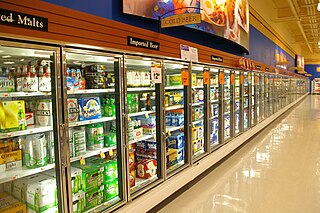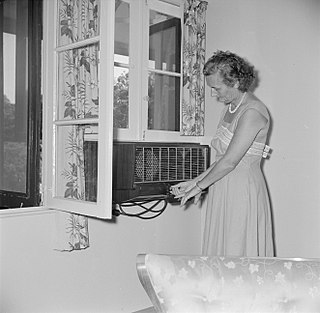
The term refrigeration denotes cooling of a space, substance or system to lower and/or maintain its temperature below the ambient one. Refrigeration is considered an artificial, or human-made, cooling method.

Heating, ventilation, and air conditioning (HVAC) is the use of various technologies to control the temperature, humidity, and purity of the air in an enclosed space. Its goal is to provide thermal comfort and acceptable indoor air quality. HVAC system design is a subdiscipline of mechanical engineering, based on the principles of thermodynamics, fluid mechanics, and heat transfer. "Refrigeration" is sometimes added to the field's abbreviation as HVAC&R or HVACR, or "ventilation" is dropped, as in HACR.
The following is a timeline of low-temperature technology and cryogenic technology. It also lists important milestones in thermometry, thermodynamics, statistical physics and calorimetry, that were crucial in development of low temperature systems.

A dehumidifier is an air conditioning device which reduces and maintains the level of humidity in the air. This is done usually for health or thermal comfort reasons, or to eliminate musty odor and to prevent the growth of mildew by extracting water from the air. It can be used for household, commercial, or industrial applications. Large dehumidifiers are used in commercial buildings such as indoor ice rinks and swimming pools, as well as manufacturing plants or storage warehouses. Typical air conditioning systems combine dehumidification with cooling, by operating cooling coils below the dewpoint and draining away the water that condenses.

John B. Gorrie was a Nevisian-born American physician and scientist, credited as the inventor of mechanical refrigeration.

A refrigerator, colloquially fridge, is a commercial and home appliance consisting of a thermally insulated compartment and a heat pump that transfers heat from its inside to its external environment so that its inside is cooled to a temperature below the room temperature. Refrigeration is an essential food storage technique around the world. The lower temperature lowers the reproduction rate of bacteria, so the refrigerator reduces the rate of spoilage. A refrigerator maintains a temperature a few degrees above the freezing point of water. The optimal temperature range for perishable food storage is 3 to 5 °C. A similar device that maintains a temperature below the freezing point of water is called a freezer. The refrigerator replaced the icebox, which had been a common household appliance for almost a century and a half. The United States Food and Drug Administration recommends that the refrigerator be kept at or below 4 °C (40 °F) and that the freezer be regulated at −18 °C (0 °F).

UTC Climate, Controls & Security was a global provider of building technologies offering fire safety, security, building automation, heating, ventilating, air-conditioning, and refrigeration systems and services. A wholly owned subsidiary of United Technologies Corporation, UTC Climate, Controls & Security was a $16.7 billion company with 55,000 employees serving customers in more than 180 countries.

An icebox is a compact non-mechanical refrigerator which was a common early-twentieth-century kitchen appliance before the development of safely powered refrigeration devices. Before the development of electric refrigerators, iceboxes were referred to by the public as "refrigerators". Only after the invention of the modern electric refrigerator did early non-electric refrigerators become known as iceboxes. The terms ice box and refrigerator were used interchangeably in advertising as long ago as 1848.

An icemaker, ice generator, or ice machine may refer to either a consumer device for making ice, found inside a home freezer; a stand-alone appliance for making ice, or an industrial machine for making ice on a large scale. The term "ice machine" usually refers to the stand-alone appliance.
A ton of refrigeration, also called a refrigeration ton (RT), is a unit of power used in some countries to describe the heat-extraction capacity of refrigeration and air conditioning equipment. It was originally defined as the rate of heat transfer that results in the freezing or melting of 1 short ton of pure ice at 0 °C (32 °F) in 24 hours.

Vapour-compression refrigeration or vapor-compression refrigeration system (VCRS), in which the refrigerant undergoes phase changes, is one of the many refrigeration cycles and is the most widely used method for air conditioning of buildings and automobiles. It is also used in domestic and commercial refrigerators, large-scale warehouses for chilled or frozen storage of foods and meats, refrigerated trucks and railroad cars, and a host of other commercial and industrial services. Oil refineries, petrochemical and chemical processing plants, and natural gas processing plants are among the many types of industrial plants that often utilize large vapor-compression refrigeration systems. Cascade refrigeration systems may also be implemented using two compressors.
Solar air conditioning, or "solar-powered air conditioning", refers to any air conditioning (cooling) system that uses solar power.

District cooling is the cooling equivalent of district heating. Working on broadly similar principles to district heating, district cooling delivers chilled water to buildings like offices and factories needing cooling. In winter, the source for the cooling can often be seawater, so it is a cheaper resource than using electricity to run compressors for cooling. Alternatively, District Cooling can be provided by a Heat Sharing Network which enables each building on the circuit to use a heat pump to reject heat to an ambient ground temperature circuit.

Air conditioning, often abbreviated as A/C (US), AC (US), or air con (UK), is the process of removing heat from an enclosed space to achieve a more comfortable interior environment and in some cases also strictly controlling the humidity of internal air. Air conditioning can be achieved using a mechanical 'air conditioner' or alternatively a variety of other methods, including passive cooling or ventilative cooling. Air conditioning is a member of a family of systems and techniques that provide heating, ventilation, and air conditioning (HVAC). Heat pumps are similar in many ways to air conditioners, but use a reversing valve to allow them to heat and also cool an enclosed space.
Friedrich Air Conditioning is an American privately held company that manufactures commercial-grade room air conditioners and specialty cooling products for residential and light commercial applications. The company is based in Uptown, San Antonio, Texas.

Pumpable icetechnology (PIT) uses thin liquids, with the cooling capacity of ice. Pumpable ice is typically a slurry of ice crystals or particles ranging from 5 micrometers to 1 cm in diameter and transported in brine, seawater, food liquid, or gas bubbles of air, ozone, or carbon dioxide.

Ice storage air conditioning is the process of using ice for thermal energy storage. The process can reduce energy used for cooling during times of peak electrical demand. Alternative power sources such as solar can also use the technology to store energy for later use. This is practical because of water's large heat of fusion: one metric ton of water can store 334 megajoules (MJ) of energy, equivalent to 93 kWh.

The International Institute of Refrigeration (IIR), is an independent intergovernmental science and technology-based organization which promotes knowledge of refrigeration and associated technologies and applications on a global scale that improve quality of life in a cost-effective and environmentally sustainable manner, including:

GEA Bock GmbH is part of the GEA Group. The company is a manufacturer of compressors and condensing units for stationary and mobile refrigeration and air-conditioning. The products are exclusively used in commercial and industrial environments.
J & E Hall is an English manufacturer of refrigeration equipment. It was originally established as an iron works in Dartford, Kent in 1785, with products including papermaking machines, steam engines and gun carriages, before it started producing refrigeration machinery in the 1880s. During the early 20th century, the company diversified to produce commercial vehicles, lifts and escalators, before refocusing on its core refrigeration and air conditioning products in the late 1960s. The company retains a head office and some R&D facilities in Dartford.

















